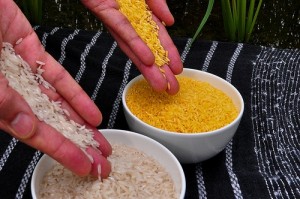A genetically modified organism (GMO) is an organism or microorganism whose genetic material has been altered to contain a segment of DNA from another organism. Modern recombinant DNA technology enables the “stitching together†of pieces of DNA, regardless of the source of the pieces. Since the 1980s, this technology has been used extensively in the lab by researchers for countless purposes: to make copies of genes or proteins, to determine gene function, to study gene expression patterns, and to create models for human disease. One application has been to generate food crops that are modified in a way that is advantageous to either the producer or the consumer. Currently the GM crops on the market have bacterial genes introduced into their genomes that encode for pest or herbicide resistance. In theory, this should cut down on the amount of chemicals a farmer needs to spray, but in practice that goal has not been realized as pests and weeds become resistant to the chemicals being used.

In the US, the most commonly found GM crops are:
* Soy
* Corn
* Cotton
* Canola
Most scientists agree that GM foods are safe. There is concern among scientists that the vocal resistance of certain individuals to GMOs is due, in part, to a lack of understanding of the technology and the prevalence of misinformation. Man has been “genetically modifying†food crops through selective breeding since we moved from hunting and gathering to agriculture over 10,000 years ago. Modern technology speeds up this process. However, that does not mean the technology should be given blanket approval. GM crops have been planted extensively for a little over a decade. While no negative health consequences have been detected (or are anticipated), the relative newness of GM crops requires that we continue to monitor for health impacts. At present, the ecological concerns that stem from the way GM crops are planted are a more pressing concern. In some states, public unease with GMOs has resulted in attempted legislation to require labeling of food products that contain GM ingredients.
CLICK HERE for an informative video presentation on GMO crops
